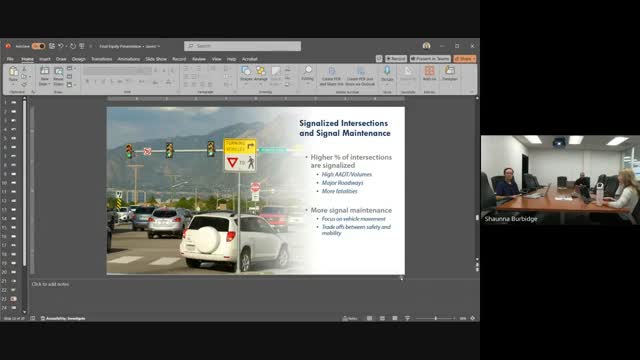Intersection safety crisis demands urgent action and solutions
October 13, 2024 | Utah Department of Transportation, Utah Transportation, State Agencies, Organizations, Utah Executive Branch, Utah
This article was created by AI summarizing key points discussed. AI makes mistakes, so for full details and context, please refer to the video of the full meeting. Please report any errors so we can fix them. Report an error »

During a recent government meeting, officials discussed the pressing issues surrounding signalized intersections and their maintenance, highlighting the complexities and safety concerns associated with major roadways. The conversation emphasized that a significant percentage of intersections are signalized, particularly in areas with high traffic volumes, such as Redwood Road, which features dedicated turn lanes and center medians.
Data presented indicated that these high-traffic areas are prone to severe injuries and fatalities, especially for pedestrians. The risk of accidents increases dramatically when crossing busy roadways compared to quieter neighborhood streets. This raises critical questions about the balance between vehicle mobility and pedestrian safety, as officials acknowledged the need for signal maintenance to improve traffic flow while also considering the safety of those reliant on walking, biking, or public transit.
The discussion also touched on the broader implications of road design, noting that wider roadways and higher vehicle volumes contribute to various externalities, including air and noise pollution. Residents living near major arterials face increased health risks, such as respiratory issues and heart disease, due to particulate pollution. Noise pollution was highlighted as a significant concern, affecting both mental and physical health, particularly for those unaccustomed to high traffic noise.
Additionally, the meeting revealed that 64% of roads in vulnerable areas suffer from fair to poor pavement quality, further complicating the transportation equity landscape. The officials underscored the need for a comprehensive approach to address these challenges, balancing the demands of traffic efficiency with the health and safety of community members.
Data presented indicated that these high-traffic areas are prone to severe injuries and fatalities, especially for pedestrians. The risk of accidents increases dramatically when crossing busy roadways compared to quieter neighborhood streets. This raises critical questions about the balance between vehicle mobility and pedestrian safety, as officials acknowledged the need for signal maintenance to improve traffic flow while also considering the safety of those reliant on walking, biking, or public transit.
The discussion also touched on the broader implications of road design, noting that wider roadways and higher vehicle volumes contribute to various externalities, including air and noise pollution. Residents living near major arterials face increased health risks, such as respiratory issues and heart disease, due to particulate pollution. Noise pollution was highlighted as a significant concern, affecting both mental and physical health, particularly for those unaccustomed to high traffic noise.
Additionally, the meeting revealed that 64% of roads in vulnerable areas suffer from fair to poor pavement quality, further complicating the transportation equity landscape. The officials underscored the need for a comprehensive approach to address these challenges, balancing the demands of traffic efficiency with the health and safety of community members.
View full meeting
This article is based on a recent meeting—watch the full video and explore the complete transcript for deeper insights into the discussion.
View full meeting

